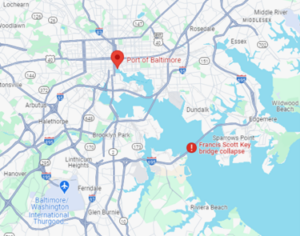 The Francis Scott Key Bridge in Baltimore, MD collapsed in the wee hours this morning after it was struck by a containership exiting a nearby terminal. According to news reports, the containership, under charter to Maersk for its Asia-U.S. East Coast TP12 service, lost power before veering off course and colliding with the bridge.
The Francis Scott Key Bridge in Baltimore, MD collapsed in the wee hours this morning after it was struck by a containership exiting a nearby terminal. According to news reports, the containership, under charter to Maersk for its Asia-U.S. East Coast TP12 service, lost power before veering off course and colliding with the bridge.
OCEANAIR leaders and staff are deeply saddened by the day’s events and are keeping those impacted in our thoughts and prayers during this difficult time.
Marine cargo insurer, WK Webster, has warned Maersk customers, “There is likely to be significant cargo loss and damage as a result of this very serious incident, including to a number of containers which are reported to be hanging from the bridge. It also seems almost certain that the vessel will not be proceeding with the voyage in the near future resulting in serious delays to all cargo on board.”
The four-lane Francis Scott Key Bridge, which spanned 1.6 miles, served as crucial link between the Baltimore Beltway (I-695) and Baltimore Harbor, carrying roughly 30,000 vehicles per day. It also had a vital role in commercial shipping, providing access to the various terminals Port of Baltimore.
Impact on East Coast Trade
The most immediate impact will be on vessels and cargos already at the Port of Baltimore. According to its website, the port has suspended all vessel traffic until further notice, trapping at least 40 vessels in Baltimore Harbor, just up river from where the bridge collapsed. Those vessels and export cargoes already gated in will have to wait for the waterway to reopen or be rerouted by truck or rail to other ports once an alternative traffic route has been determined. However, import containers will still be allowed to be picked up as trucking and rail activities are still operational.
While the effects from this morning’s devastating events will not be quite as dramatic as the bridge collapse itself, ripple effects will likely cause headaches for importers and exporters over the coming weeks.
The Port of Baltimore handles roughly 1.1 million TEU a year, which will now have to be routed to other ports in the region. The Port also boasts the deepest draft on the East Coast, at 15.2 meters, which means only a handful of ports in the region would be able to accommodate ultra large container vessels (ULCV’s) diverted from Baltimore, specifically, Norfolk, New York, and Savannah.
While these ports would likely appreciate the extra business, there is only so much port capacity available. According to eeSea liner, Norfolk, New York, and Savannah had the highest terminal utilization levels on the East Coast in 2023, at 67%, 75%, and 65%, respectively.
To minimize the impact at the larger East Coast ports and avoid lengthy vessel queues, services deploying smaller vessels will likely opt for Philadelphia, Boston, and Wilmington, with the latter two having utilization levels of 46% and 26%, respectively, over the same period.
With 21,000 TEU to be diverted weekly to just six ports, there is a real potential for port congestion which could cause significant disruption to supply chains, putting even more pressure on spot rates which are just coming off Red Sea-crisis induced highs.
The diverted containers will also drive up demand for both trucking and rail, which will tighten availability capacity across the region, likely boosting rates in the process.
OCEANAIR will continue to monitor the situation and will provide updates as they become available.

